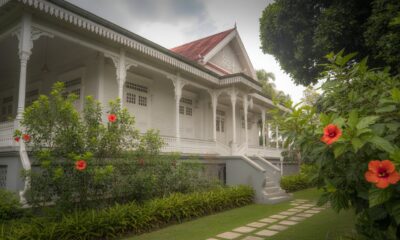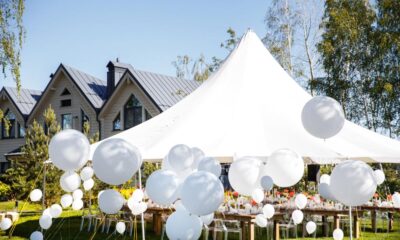Travel
How Remote Is the Upper Mustang Trek?

Upper Mustang, also known as the “Last Forbidden Kingdom,” is located in the northern part of the Annapurna region, bordering Tibet. The area was closed off to foreign travelers until 1992 when the government of Nepal began to allow limited trekking in the region. Even today, access to Upper Mustang is restricted, and trekkers require special permits to visit. This means that the area has remained relatively untouched by the tourism boom that has affected other parts of Nepal.
The remoteness of Upper Mustang is not only due to its physical location but also its unique cultural landscape. The people of Upper Mustang, known as the Mustangis, have preserved their Tibetan way of life for centuries. Their language, customs, and religious practices are deeply tied to Tibetan Buddhism, making Upper Mustang a living museum of a culture that is rapidly disappearing in other parts of the Himalayas.
The trek itself is a journey through a barren, high-altitude landscape that is starkly beautiful. The region is characterized by narrow canyons, caves, and rock formations, all set against a backdrop of towering snow-capped peaks. The terrain is challenging, with steep ascents and descents, making it a physically demanding trek. However, the sense of remoteness and the opportunity to explore a culture that has remained largely unchanged for centuries make it a sought-after destination for adventurous trekkers.
Why Is Upper Mustang Considered Remote?
Several factors contribute to the remoteness of the Upper Mustang Trek. One of the primary reasons is its geographic location. The region lies in a remote corner of Nepal, far from major cities and well-established trekking routes. To get to Upper Mustang, trekkers must first reach Pokhara, a popular tourist destination, and then travel by road or air to Jomsom, the starting point of the trek. From Jomsom, trekkers must trek for several days to reach Upper Mustang, passing through rugged terrain and isolated villages along the way.
The terrain of Upper Mustang itself adds to the sense of isolation. The region is located in a rain shadow created by the Himalayas, resulting in an arid and inhospitable climate. The landscape is stark and barren, with few trees and little vegetation. This is a far cry from the lush, green forests found in other parts of Nepal, adding to the feeling of being in a remote and uninhabited world. The high-altitude environment, combined with the challenging terrain, means that the trek is not for the faint of heart, and it requires trekkers to be in good physical condition.
Another reason for the remoteness of the Upper Mustang Trek is the lack of modern infrastructure. Unlike other popular trekking routes in Nepal, such as the Annapurna Circuit or Everest Base Camp Trek, Upper Mustang is not heavily developed in terms of accommodation, transportation, and amenities. While there are tea houses and basic lodges along the trail, the facilities are often simple and rudimentary. This lack of modern conveniences can make the trek feel even more remote and disconnected from the outside world.
Additionally, the restricted access to the region adds to its sense of remoteness. The government of Nepal only issues a limited number of permits for Upper Mustang each year, and trekkers must apply for a special permit in advance. This means that the number of visitors to the region is strictly controlled, and the area remains relatively untouched by mass tourism. For those who do manage to obtain a permit and complete the trek, the sense of having experienced something exclusive and rare adds to the allure of the journey.
The Cultural Significance of Upper Mustang’s Remoteness
Upper Mustang’s remoteness is not just about its physical isolation, but also about its cultural heritage. The region is home to a Tibetan Buddhist community that has preserved its traditions and way of life for centuries. The people of Upper Mustang are direct descendants of Tibetan settlers who migrated to the region hundreds of years ago. They have maintained a distinct culture that is influenced by both Tibetan and Nepali traditions, creating a unique blend of customs, language, and religion.
The isolation of Upper Mustang has helped protect this cultural heritage. While many Tibetan Buddhist communities in Nepal and Tibet have been impacted by modernization and political changes, Upper Mustang has remained largely unaffected by outside influences. The remote nature of the region has allowed its inhabitants to continue practicing their ancient customs, including religious ceremonies, festivals, and rituals, that have been passed down through generations.
One of the most notable aspects of Upper Mustang’s culture is its religious significance. The region is dotted with monasteries, stupas, and caves that are sacred to the Mustangis. The monasteries, such as the famous Lo Manthang Monastery, are centers of Tibetan Buddhism and serve as places of worship, learning, and meditation. The trek takes travelers past these spiritual landmarks, offering a glimpse into a way of life that is deeply rooted in faith and tradition.
The isolation of Upper Mustang also means that its people have maintained a lifestyle that is closely tied to the land and the environment. Agriculture is still the primary source of livelihood for many families, and the region’s traditional farming methods have remained unchanged for centuries. This is in stark contrast to the more urbanized areas of Nepal, where modern farming techniques and industrialization have transformed the way people live and work.
The Trekking Experience in Upper Mustang
The experience of trekking in Upper Mustang is a journey through both physical and cultural isolation. The trek takes travelers through a landscape that is both rugged and breathtakingly beautiful. The trail passes through narrow gorges, ancient villages, and high-altitude deserts, offering stunning views of the surrounding mountains. The dramatic scenery, combined with the sense of solitude, makes the trek feel like a journey into another world.
The trail also offers trekkers the opportunity to explore some of the most remote and historically significant villages in Nepal. The village of Lo Manthang, for example, is the capital of Upper Mustang and is home to around 1,000 people. It is a walled city with narrow alleyways, traditional mud-brick houses, and ancient monasteries. The village is steeped in history, and it is said that the king of Mustang still resides there, making Lo Manthang the last remaining medieval kingdom in Nepal.
Other villages along the trek, such as Chhuksang, Samar, and Ghiling, offer a glimpse into the daily lives of the Mustangis. These villages are characterized by their traditional architecture, including houses made of stone and mud, and their remote location, which adds to their sense of isolation. Many of the villages are still accessible only on foot, further emphasizing the region’s remoteness.
In addition to the cultural and historical sites, trekkers will encounter the daily challenges of high-altitude trekking. The journey through Upper Mustang involves long days of walking, often in challenging conditions. The high-altitude environment can make breathing difficult, and trekkers must take precautions to avoid altitude sickness. The terrain is also rugged, with steep ascents and descents that can be physically demanding. However, the rewards are well worth the effort, as the sense of remoteness and the opportunity to experience a unique culture make the trek unforgettable.
Conclusion
Yes, the Upper Mustang Trek is one of the most remote and unique trekking experiences in Nepal. Its geographic isolation, challenging terrain, and cultural significance set it apart from other trekking routes in the country. The trek offers an opportunity to explore a part of Nepal that has remained largely untouched by modernity, providing a glimpse into a way of life that has remained unchanged for centuries. For those seeking an adventure off the beaten path, the Upper Mustang Trek offers an experience that is both physically and spiritually rewarding.
Travel
The Hudson: A River of History, Culture, and Nature

Introduction
The Hudson is more than just a river. It is a symbol of history, culture, and natural beauty that has shaped life in the northeastern United States for centuries. Flowing for about 315 miles, River stretches from the Adirondack Mountains in upstate New York all the way to the New York Harbor, where it meets the Atlantic Ocean. Over time, It has played an important role in travel, trade, and even art, making it one of the most famous rivers in America.
Geography and Course
The Hudson begins at Lake Tear of the Clouds, high in the Adirondack Mountains. From there, it flows south through valleys and cities before reaching its widest point at Haverstraw Bay. The river finally empties into the Upper New York Bay, where it meets the Atlantic Ocean. Interestingly, It is actually a tidal estuary, meaning ocean tides push saltwater north into the river. This mix of saltwater and freshwater creates a unique environment for fish, birds, and plants.
The Hudson in History
For centuries, River has been important to both Native Americans and European settlers. The Mohican people once lived along its banks, using the river as a source of food and transportation. In 1609, the English explorer Henry Hudson, sailing for the Dutch, traveled up the river while searching for a new route to Asia. His journey led to Dutch settlements in the region, which later became New York.
During the American Revolution, It played a key role. Control of the river was vital for moving troops and supplies. Forts and chains were built across it to block enemy ships. Because of its strategic location, George Washington called the “key to the continent.”
Economic Importance
It has always been a lifeline for trade. In the 19th century, the construction of the Erie Canal connected the Hudson River to the Great Lakes, making it a major transportation route for goods. This helped New York City grow into one of the world’s biggest trade centers. Even today, ships, barges, and ferries travel along the river, supporting commerce and tourism.
The Hudson and American Art
The Hudson is also known for its impact on art. In the 1800s, a group of painters known as the Hudson River School found inspiration in the river’s beauty. They painted landscapes filled with dramatic skies, mountains, and waterways. Their work celebrated nature and encouraged people to appreciate America’s wild landscapes. This art movement helped create an early love for preserving natural areas.
Environmental Challenges and Recovery
Like many rivers near large cities, the Hudson faced serious pollution during the 20th century. Factories dumped chemicals into the water, harming fish and wildlife. By the 1970s, the river had become heavily polluted. However, thanks to strong environmental movements and cleanup efforts, the Hudson has made an impressive recovery. Today, fish species such as striped bass have returned, and bald eagles are once again seen along its shores.
The Hudson Today
Modern life along the Hudson is full of activity. Cities such as Albany, Poughkeepsie, and New York City sit on its banks. Tourists enjoy river cruises, hiking trails, and waterfront parks. Every fall, visitors come to see the colorful foliage along the Hudson Valley, one of the most scenic areas in the United States. The river continues to provide drinking water, recreation, and inspiration for millions of people.
Conclusion
The Hudson is not just a river it is a thread connecting history, art, and everyday life. From its role in Native American culture and the American Revolution to its importance in trade and environmental recovery, the Hudson remains a vital part of the region. It is a place where nature and people meet, and it continues to inspire all who visit its shores.
Travel
Skip the DMV: kwik trip license plate renewal

Introduction
Standing in line at the DMV for hours just to renew your license plate feels like a relic from the past. Kwik Trip, the beloved Midwest convenience store chain, has revolutionized this mundane task by offering quick and efficient license plate renewal services right at their locations.
With over 800 stores across Wisconsin, Minnesota, and Iowa, kwik trip license plate renewal has become more than just a place to grab coffee and snacks. They’ve partnered with state agencies to provide essential services that save you time and hassle. License plate renewal is one of their most popular offerings, allowing you to complete this annual requirement while picking up your morning coffee or filling up your gas tank.
This comprehensive guide will walk you through everything you need to know about renewing your license plate at Kwik Trip, from the step-by-step process to what documents you’ll need and common troubleshooting tips.
How to Renew Your License Plate at Kwik Trip: Step-by-Step Guide
Renewing your license plate at Kwik Trip is surprisingly straightforward. The entire process typically takes just a few minutes, making it far more convenient than traditional DMV visits.
Step 1: Locate a Participating Kwik Trip
Not all Kwik Trip locations offer license plate renewal services. Use the Kwik Trip store locator on their website or call ahead to confirm your nearest location provides this service. Most larger stores and those in urban areas typically offer renewal services.
Step 2: Gather Your Required Documents
Before heading to the store, make sure you have all necessary documentation. We’ll cover the specific requirements in detail below, but generally, you’ll need your current registration and a valid form of payment.
Step 3: Visit the Customer Service Counter
Once at the store, head to the customer service counter. Look for signs indicating “License Plate Renewal” or “Vehicle Registration Services.” During busy periods, you might need to take a number or wait briefly.
Step 4: Provide Your Information
Hand over your current vehicle registration to the Kwik Trip associate. They’ll input your information into their system, which connects directly to state databases to verify your eligibility and calculate renewal fees.
Step 5: Review and Confirm Details
The associate will display your vehicle information on a screen or printed form. Double-check that all details are correct, including your name, address, vehicle make and model, and VIN number. Any errors should be corrected before proceeding.
Step 6: Pay Your Renewal Fee
License plate renewal fees vary by state and vehicle type. The system will automatically calculate your fee, including any applicable taxes or additional charges. Kwik Trip accepts cash, credit cards, and debit cards for payment.
Step 7: Receive Your New Registration
After payment processing, you’ll receive your new registration documents immediately. Some states also provide new license plate stickers at the time of renewal, while others mail them separately to your registered address.
Benefits of Renewing at Kwik Trip
Choosing Kwik Trip for your license plate renewal offers several compelling advantages over traditional DMV visits.
Extended Operating Hours
Most Kwik Trip locations are open 24 hours a day, seven days a week. This means you can renew your license plate early in the morning, late at night, or on weekends when DMV offices are closed. The flexibility fits perfectly into busy schedules.
No Appointment Necessary
Unlike many DMV services that require advance scheduling, Kwik Trip operates on a walk-in basis. You can handle your renewal whenever it’s convenient, without planning weeks ahead.
Faster Service Times
The average license plate renewal at Kwik Trip takes between 3-7 minutes. Compare this to typical DMV wait times, which can stretch to an hour or more during peak periods.
Multiple Errands in One Trip
Since Kwik Trip is a full-service convenience store, you can combine your license plate renewal with other tasks like getting gas, buying groceries, or grabbing a meal. This efficiency saves both time and fuel.
Knowledgeable Staff
Kwik Trip associates receive specific training on vehicle registration processes. They can answer questions about renewal requirements, explain fees, and help troubleshoot common issues.
What You Need to Bring
Proper preparation ensures a smooth renewal experience. Here’s exactly what you need to bring to Kwik Trip for license plate renewal.
Required Documents
Your current vehicle registration is the primary document you’ll need. This should be the most recent registration card issued by your state’s DMV or equivalent agency. Make sure it’s not expired by more than the grace period allowed in your state.
Valid Payment Method
Kwik Trip accepts various payment options including cash, major credit cards (Visa, MasterCard, Discover, American Express), and debit cards. Some locations may also accept checks, though policies vary by store.
Identification (If Required)
While not always necessary for standard renewals, bring a valid driver’s license or state-issued ID card. This may be required if there are discrepancies in your information or if you’re renewing on behalf of someone else.
Additional Documentation for Special Cases
If you’ve recently moved, you may need proof of your new address. For vehicles with liens, ensure your registration reflects the correct lienholder information. Commercial vehicles may require additional documentation depending on state regulations.
Troubleshooting Common Issues
Even with proper preparation, you might encounter some challenges during the renewal process. Here are solutions to the most common problems.
System Shows Outstanding Issues
If the computer system indicates problems like unpaid tickets or insurance lapses, you’ll need to resolve these with the appropriate agencies before renewal. Kwik Trip cannot override these system blocks, but they can provide information about which agency to contact.
Address Changes
If you’ve moved since your last registration, some states allow address updates during renewal at Kwik Trip. Others require you to update your address separately through the DMV. The associate can inform you of your state’s specific requirements.
Lost Registration Documents
Without your current registration, Kwik Trip may still be able to process your renewal using your license plate number and personal information. However, this depends on state regulations and system capabilities. Call ahead to confirm if this is possible.
Payment Issues
If your payment method is declined, Kwik Trip accepts multiple forms of payment. For exact cash payments, note that some locations may have limited change availability for large bills.
Vehicle Not Found in System
Occasionally, vehicles don’t appear in the state database due to data entry errors or recent purchases. If this happens, you’ll likely need to visit a DMV office to resolve the issue before renewing at Kwik Trip.
Frequently Asked Questions
Can I renew an expired license plate at Kwik Trip?
This depends on your state’s regulations and how long the registration has been expired. Most states allow renewal within a certain grace period (typically 30-60 days). Beyond that, you may need to visit the DMV directly.
Do all Kwik Trip locations offer license plate renewal?
No, not all locations provide this service. Larger stores and those in metropolitan areas are more likely to offer renewals. Use the store locator on Kwik Trip’s website or call ahead to confirm availability.
Can I get specialty or personalized plates renewed at Kwik Trip?
Standard specialty plates (like disability or veteran plates) can typically be renewed at Kwik Trip. However, new personalized plate applications usually require DMV processing.
What if I need to make changes to my registration information?
Simple changes like address updates may be possible during renewal, depending on state rules. More complex changes, such as adding or removing names from the title, typically require DMV processing.
Are there any vehicles that cannot be renewed at Kwik Trip?
Some commercial vehicles, motorcycles, or vehicles with complex registration situations may not be eligible for renewal at convenience stores. The system will indicate if DMV processing is required.
Save Time and Get Back on the Road
License plate renewal doesn’t have to be a dreaded annual chore. Kwik Trip has transformed this process into a quick, convenient task that fits seamlessly into your daily routine. With extended hours, knowledgeable staff, and efficient processing times, you can complete your renewal in minutes rather than hours.
Next time your registration renewal notice arrives in the mail, skip the DMV and head to your local participating kwik trip license plate renewal instead. Bring your current registration and payment method, and you’ll be back on the road with current tags before you know it. Check Kwik Trip’s website for the nearest participating location and make your next license plate renewal the easiest one yet.
Travel
How Many Yards of Concrete Are in a Cement Truck?

Introduction
Planning a concrete project requires precise calculations, and knowing how much concrete fits in a cement truck is essential for budgeting and scheduling. Most how many yards of concrete are in a cement truck standard cement trucks carry between 8 to 12 cubic yards of concrete, but several factors can influence this capacity.
Understanding concrete truck volumes helps contractors, builders, and homeowners make informed decisions about material orders. Ordering too little concrete can delay projects and create unsightly seams, while ordering too much leads to waste and unnecessary costs.
This guide breaks down everything you need to know about cement truck capacities, from standard volumes to the factors that affect how much concrete you’ll actually receive on-site.
Standard Cement Truck Capacity
The most common cement trucks on construction sites carry 10 cubic yards of concrete. However, capacity varies based on truck size and design.
Small Cement Trucks
Small cement trucks typically hold 3 to 6 cubic yards of concrete. These trucks work well for residential projects with limited access, such as sidewalk repairs, small patios, or foundation work in tight spaces. how many yards of concrete are in a cement truck compact size allows them to navigate narrow driveways and streets where larger trucks cannot reach.
Standard Cement Trucks
Standard cement trucks carry 8 to 12 cubic yards of concrete. The 10-yard truck represents the industry standard and handles most residential and commercial projects efficiently. These trucks balance capacity with maneuverability, making them suitable for driveways, foundations, and medium-sized slabs.
Large Cement Trucks
Large cement trucks can carry up to 14 cubic yards of concrete. These high-capacity trucks serve major commercial and industrial projects where maximum efficiency matters. However, their size limits access to certain job sites, and local weight restrictions may prevent them from traveling on some roads.
Factors Affecting Concrete Volume
Several factors influence how much concrete a truck can actually deliver to your project site.
Truck Weight Limits
Federal and state regulations limit the total weight of loaded cement trucks. A cubic yard of concrete weighs approximately 4,000 pounds, and trucks must stay within legal weight limits for road safety. This means a truck’s maximum concrete capacity depends on both drum size and weight restrictions.
Concrete Mix Design
Different concrete mixes have varying densities. Lightweight concrete mixes allow trucks to carry more volume, while heavy mixes with steel reinforcement reduce the maximum cubic yards per load. Your concrete supplier will adjust the load size based on the specific mix you’ve ordered.
Travel Distance and Time
Long travel distances from the concrete plant to your job site affect the maximum load size. Concrete begins setting within 90 minutes of mixing, so suppliers may reduce load sizes for distant deliveries to ensure workable concrete upon arrival.
Site Accessibility
Narrow roads, low bridges, or weight-restricted areas may require smaller trucks with reduced capacity. Suppliers will assess your site access and recommend appropriate truck sizes to ensure safe delivery.
Calculating Concrete Needs for Projects
Accurate concrete calculations prevent delays and minimize waste on your construction project.
Measuring Your Project Area
Start by measuring the length, width, and depth of your concrete area in feet. Multiply these dimensions to get cubic feet, then divide by 27 to convert to cubic yards. For example, a 20-foot by 20-foot patio that’s 4 inches thick requires 9.9 cubic yards of concrete.
Adding Extra for Waste
Construction professionals typically order 5% to 10% extra concrete to account for waste, spillage, and minor measurement variations. This buffer ensures you have enough material to complete your project without emergency deliveries.
Multiple Truck Considerations
Large projects may require multiple truck loads. Plan delivery schedules carefully to ensure continuous concrete placement. Most concrete plants can coordinate sequential deliveries to maintain work flow without extended delays between loads.
Specialty Applications
Some projects require specific concrete volumes. Foundations typically need precise amounts to avoid weak spots, while decorative concrete may require smaller, more manageable loads for careful placement and finishing.
Environmental Considerations and Waste Reduction
Minimizing concrete waste benefits both your budget and the environment.
Accurate Ordering
Precise measurements and calculations reduce excess concrete that becomes waste. Work with experienced suppliers who can help refine your estimates based on project specifics and their delivery experience.
Concrete Recycling
Leftover concrete doesn’t have to go to landfills. Many suppliers offer concrete recycling programs that process unused material into aggregate for future projects. Some contractors use excess concrete for walkways, equipment pads, or other small applications on-site.
Timing and Coordination
Proper scheduling ensures concrete arrives when your crew is ready to place it. Delays can cause concrete to begin setting in the truck, potentially requiring disposal and reordering.
Sustainable Practices
Some concrete suppliers offer eco-friendly mixes that incorporate recycled materials or reduce carbon emissions during production. These options may affect truck capacity slightly but support environmental sustainability goals.
Frequently Asked Questions
How much does a cubic yard of concrete weigh?
A cubic yard of concrete typically weighs between 3,500 and 4,000 pounds, depending on the mix design and aggregate types used.
Can I order partial loads from cement trucks?
Yes, most suppliers offer partial loads, though minimum order requirements and delivery fees may apply. Small loads are often more expensive per cubic yard than full truck loads.
How long can concrete stay in the truck before it’s unusable?
Concrete typically remains workable for 90 minutes after mixing, though hot weather can reduce this time to 60 minutes or less. Cold weather may extend working time.
What happens if I order too much concrete?
Excess concrete can sometimes be returned to the plant for credit, used for other on-site applications, or disposed of according to local regulations. Most suppliers charge disposal fees for unused concrete.
Do different concrete types affect truck capacity?
Yes, specialty concrete mixes with different densities can increase or decrease the volume a truck can legally carry while staying within weight limits.
Planning Your Concrete Delivery Successfully
Understanding cement truck capacities helps ensure your concrete project proceeds smoothly from planning to completion. Standard trucks carrying 10 cubic yards handle most residential and commercial applications, while project-specific factors may require different truck sizes.
Work closely with your concrete supplier to determine the right truck size and number of loads for your project. Provide accurate measurements, site access information, and project timeline details to optimize delivery efficiency.
Remember that proper planning reduces waste, saves money, and supports environmental sustainability. Take time to calculate your concrete needs accurately, and don’t hesitate to consult with experienced suppliers who can guide you through the ordering process for optimal results.
-

 Technology3 years ago
Technology3 years agoIs Camegle Legit Or A Scam?
-

 Travel3 years ago
Travel3 years agoNEW ZEALAND VISA FOR ISRAELI AND NORWEGIAN CITIZENS
-

 Uncategorized3 years ago
Uncategorized3 years agoAMERICAN VISA FOR NORWEGIAN AND JAPANESE CITIZENS
-

 Technology3 years ago
Technology3 years agoRNDcoin: Korea’s first blockchain project and a world-class cryptocurrency
-

 Fashion1 year ago
Fashion1 year agoGoda Perfume Reviews: Is It Worth Your Investment?
-

 Health3 years ago
Health3 years agoHealth Benefits Of Watermelon
-

 Home Improvement7 months ago
Home Improvement7 months agoArtificial Grass Designs: Perfect Solutions for Urban Backyards
-

 Fashion3 years ago
Fashion3 years agoBest Essentials Hoodies For Cold Weather














